






25 Messages from wildlife
In the last quarter century, nature often reminded us that the fates
of wildlife and our own species are intertwined
by Lisa Drew, reprinted from National Wildlife, April/May 1995,
with permission.
 s celebration of the first Earth Day took place across
the country in April 1970, brown pelican eggs on Anacapa Island off the
coast of Ventura, California, were breaking under the weight of incubating
adults. For four months, the birds laid eggs in a total of 552 nests without
producing any young. Finally, in July, a single chick hatched on the island,
the species' only regular nesting ground in the state. The cause of the
eggshell thinning: DDT poisoning.
s celebration of the first Earth Day took place across
the country in April 1970, brown pelican eggs on Anacapa Island off the
coast of Ventura, California, were breaking under the weight of incubating
adults. For four months, the birds laid eggs in a total of 552 nests without
producing any young. Finally, in July, a single chick hatched on the island,
the species' only regular nesting ground in the state. The cause of the
eggshell thinning: DDT poisoning.
 Of course, Anacapa's brown pelicans were not the only
animals harmed by DDT; nor were they the only pelican population in serious
trouble. But for a nation waking up to the idea that the fates of wildlife
and our own species are intertwined, the island's one chick 25 years ago
delivered a notably poignant message. And in that respect, the young bird
was not alone. For every so often, the natural world delivers to our own
species lessons that we are able to comprehend particularly well-lessons
that are in many cases taught more quietly by many other animals and plants.
Of course, Anacapa's brown pelicans were not the only
animals harmed by DDT; nor were they the only pelican population in serious
trouble. But for a nation waking up to the idea that the fates of wildlife
and our own species are intertwined, the island's one chick 25 years ago
delivered a notably poignant message. And in that respect, the young bird
was not alone. For every so often, the natural world delivers to our own
species lessons that we are able to comprehend particularly well-lessons
that are in many cases taught more quietly by many other animals and plants.
 In honor of the 25th anniversary of Earth Day, the following
list chronicles 25 of the most resonant messages this country has received
from wildlife during the last quarter century. It is no accident that many
are from birds; ever since the proverbial coal miners' canaries, birds have
been our most telling harbingers of news from and about nature.
In honor of the 25th anniversary of Earth Day, the following
list chronicles 25 of the most resonant messages this country has received
from wildlife during the last quarter century. It is no accident that many
are from birds; ever since the proverbial coal miners' canaries, birds have
been our most telling harbingers of news from and about nature.
1. Brown pelicans
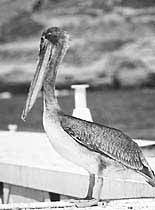
 DDT poisons birds: Only a decade before
a single brown pelican chick hatched on Anacapa in 1970, the species' young
may have numbered in the thousands on the California island. But 25 years
ago, DDT came close to wiping out the colony. The widespread pesticide and
related chemicals had also long been poisoning brown pelicans in southeastern
states-as well as ospreys, bald eagles, cormorants and many other species
all over the country.
DDT poisons birds: Only a decade before
a single brown pelican chick hatched on Anacapa in 1970, the species' young
may have numbered in the thousands on the California island. But 25 years
ago, DDT came close to wiping out the colony. The widespread pesticide and
related chemicals had also long been poisoning brown pelicans in southeastern
states-as well as ospreys, bald eagles, cormorants and many other species
all over the country.
 By 1972, the Environmental Protection Agency (EPA) had
banned the use and manufacture of DDT, not only for the sake of wildlife,
but also because it was a suspected human carcinogen. That possibility was
made all the more alarming by the knowledge-detailed by biologist Rachel
Carson a decade earlier in her landmark book Silent Spring - that DDT had
become ubiquitous, even showing up in human milk. The EPA now lists DDT,
which has diminished in the environment but is still widely present, as
a probable human carcinogen.
By 1972, the Environmental Protection Agency (EPA) had
banned the use and manufacture of DDT, not only for the sake of wildlife,
but also because it was a suspected human carcinogen. That possibility was
made all the more alarming by the knowledge-detailed by biologist Rachel
Carson a decade earlier in her landmark book Silent Spring - that DDT had
become ubiquitous, even showing up in human milk. The EPA now lists DDT,
which has diminished in the environment but is still widely present, as
a probable human carcinogen.
2. Whales
 Taking action can work: The supply of whales and the
uses for their meat, oil and other parts once seemed endless. But by 1972,
despite some protections, many species were nearly extinct - including the
massive blue whale, the "singing" humpback and the right whale.
That year, the United States declared eight whale species endangered and
passed the Marine Mammal Protection Act to protect whales and dolphins in
U.S. waters. But many countries kept whaling. Of course, whales were hardly
the first hunted animals to convey by their very absence the need for a
chance to recuperate. Bison, pronghorn and cougars, just to name a few,
were in serious trouble until they were protected. But in the case of whales,
the message was arguably heard the loudest of all, and - Save the Whales
- became a rallying cry. In 1982, the International Whaling Commission finally
agreed to a moratorium that started in 1986. Though not absolute, the uneasy
truce has helped many whale species survive and even show some signs of
recovery.
Taking action can work: The supply of whales and the
uses for their meat, oil and other parts once seemed endless. But by 1972,
despite some protections, many species were nearly extinct - including the
massive blue whale, the "singing" humpback and the right whale.
That year, the United States declared eight whale species endangered and
passed the Marine Mammal Protection Act to protect whales and dolphins in
U.S. waters. But many countries kept whaling. Of course, whales were hardly
the first hunted animals to convey by their very absence the need for a
chance to recuperate. Bison, pronghorn and cougars, just to name a few,
were in serious trouble until they were protected. But in the case of whales,
the message was arguably heard the loudest of all, and - Save the Whales
- became a rallying cry. In 1982, the International Whaling Commission finally
agreed to a moratorium that started in 1986. Though not absolute, the uneasy
truce has helped many whale species survive and even show some signs of
recovery.
3. Lake trout
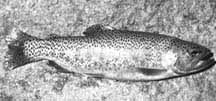
 Humans can ingest potent doses of
poisons passed up the food chain: Though the United States and Canada joined
forces in 1972 on a long-range cleanup of the Great Lakes, hundreds of pollutants
(some wind-borne from around the world) still contaminate the region. Many
wildlife species are now doing much better than they were 23 years ago.
But because of the way toxics accumulate in the food chain, they become
concentrated in fish. Many of the lakes' fish-eating birds and mammals still
have abnormal reproductive problems. In 1970, Michigan issued the first
fish-eating advisory for people. Today, every Great Lakes state warns of
human health risks from eating the region's fish-particularly lake trout
and carp. Similar warnings have been posted for fish from many other U.S.
waters.
Humans can ingest potent doses of
poisons passed up the food chain: Though the United States and Canada joined
forces in 1972 on a long-range cleanup of the Great Lakes, hundreds of pollutants
(some wind-borne from around the world) still contaminate the region. Many
wildlife species are now doing much better than they were 23 years ago.
But because of the way toxics accumulate in the food chain, they become
concentrated in fish. Many of the lakes' fish-eating birds and mammals still
have abnormal reproductive problems. In 1970, Michigan issued the first
fish-eating advisory for people. Today, every Great Lakes state warns of
human health risks from eating the region's fish-particularly lake trout
and carp. Similar warnings have been posted for fish from many other U.S.
waters.
4. Fiddler crabs
 Oil spills can have long-term, sublethal effects: In
the 1970s, scientists at a number of research institutions started reporting
results from studies of a 1969 oil spill in West Falmouth, Massachusetts.
Researchers still refer to that work, important because it was impartial
(not funded by industry) and extensive. In 1977, one study revealed that
fiddler crabs were still suffering physiological and behavioral damage.
Most striking, the oil was impairing their ability to dig burrows critical
to their survival.
Oil spills can have long-term, sublethal effects: In
the 1970s, scientists at a number of research institutions started reporting
results from studies of a 1969 oil spill in West Falmouth, Massachusetts.
Researchers still refer to that work, important because it was impartial
(not funded by industry) and extensive. In 1977, one study revealed that
fiddler crabs were still suffering physiological and behavioral damage.
Most striking, the oil was impairing their ability to dig burrows critical
to their survival.
 The oil's persistence and its sublethal effects in the
marsh prefigured the ongoing damage in Alaska from the 1989 Exxon Valdez
oil spill - even though the two ecosystems radically differ. Oiled mussel
beds in Alaska were still fouled more than five years later. And some mussel
predators in the area-including young sea otters and many species of sea
ducks-are suffering population problems that may be related to ingested
oil.
The oil's persistence and its sublethal effects in the
marsh prefigured the ongoing damage in Alaska from the 1989 Exxon Valdez
oil spill - even though the two ecosystems radically differ. Oiled mussel
beds in Alaska were still fouled more than five years later. And some mussel
predators in the area-including young sea otters and many species of sea
ducks-are suffering population problems that may be related to ingested
oil.
5. Songbirds
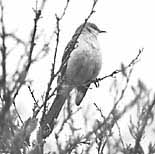
 Migrating creatures are vulnerable
at both ends of their routes: Neotropical migrant songbirds were first hit
by toxic chemicals, including pesticides and herbicides (many of which are
now far more restricted by U.S. legislation than in the middle of this century).
Then the birds were stressed by the ongoing fragmentation of North American
forests and cattle grazing of critical streamside habitat in the arid West.
In the early 1980s, at the other end of migration routes, destruction of
tropical forests in Central and South America took off in a big way-and
songbirds lost out again. One recent radar-image study of migrations suggested
songbird numbers dropped by half in 20 years. The birds' travels and diverse
habitat requirements make recovery efforts difficult, though many species
respond quickly to improved habitat.
Migrating creatures are vulnerable
at both ends of their routes: Neotropical migrant songbirds were first hit
by toxic chemicals, including pesticides and herbicides (many of which are
now far more restricted by U.S. legislation than in the middle of this century).
Then the birds were stressed by the ongoing fragmentation of North American
forests and cattle grazing of critical streamside habitat in the arid West.
In the early 1980s, at the other end of migration routes, destruction of
tropical forests in Central and South America took off in a big way-and
songbirds lost out again. One recent radar-image study of migrations suggested
songbird numbers dropped by half in 20 years. The birds' travels and diverse
habitat requirements make recovery efforts difficult, though many species
respond quickly to improved habitat.
6. Brook trout
 Pollution from far away can create disasters in pristine
places: When anglers in New York's Adirondack Mountains started coming away
empty-handed from some of the region's lakes in the 1970s, the threat of
acid rain hit home. Some lakes had no signs of any sport fish. Though not
the most sensitive species, the prized brook trout was the most widely missed.
Scientists suspected the cause was wind-borne sulfur and nitrogen (which
combine with moisture and acidify rain) from Midwestern industry. In 1986,
scientists found acid rain to be a key factor in the Adirondacks' fish decline.
By 1990, when Clean Air Act revisions required sulfur dioxide reductions,
thousands of U.S. lakes were highly acidic. Though acid rain is still a
factor in accelerated tree deaths in eastern forests, the strengthened regulations
have helped cut some of the pollution. In the Adirondacks, if lake chemistry
continues to improve, biologists may restock trout in some lakes. Last August,
industry allowances for sulfur dioxide emissions were further reduced.
Pollution from far away can create disasters in pristine
places: When anglers in New York's Adirondack Mountains started coming away
empty-handed from some of the region's lakes in the 1970s, the threat of
acid rain hit home. Some lakes had no signs of any sport fish. Though not
the most sensitive species, the prized brook trout was the most widely missed.
Scientists suspected the cause was wind-borne sulfur and nitrogen (which
combine with moisture and acidify rain) from Midwestern industry. In 1986,
scientists found acid rain to be a key factor in the Adirondacks' fish decline.
By 1990, when Clean Air Act revisions required sulfur dioxide reductions,
thousands of U.S. lakes were highly acidic. Though acid rain is still a
factor in accelerated tree deaths in eastern forests, the strengthened regulations
have helped cut some of the pollution. In the Adirondacks, if lake chemistry
continues to improve, biologists may restock trout in some lakes. Last August,
industry allowances for sulfur dioxide emissions were further reduced.
7. Mallards
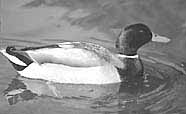
 Lead shot is poisonous: If there
ever was any question about what lead does to birds that mistake shot pellets
for food or grit, one only had to look at what lead exposure does to humans:
brain damage, behavioral problems and even death.
Lead shot is poisonous: If there
ever was any question about what lead does to birds that mistake shot pellets
for food or grit, one only had to look at what lead exposure does to humans:
brain damage, behavioral problems and even death.
 That ingested lead accidentally kills waterfowl was
first scientifically established in 1919. By the early 1970s, lead shot
in wetland bottoms was killing as many as three million birds a year, including
bald eagles that preyed on lead-poisoned ducks. Of all the birds affected,
mallards probably have been the most missed-in part because of their relative
lack of shyness around people and their comparatively large numbers.
That ingested lead accidentally kills waterfowl was
first scientifically established in 1919. By the early 1970s, lead shot
in wetland bottoms was killing as many as three million birds a year, including
bald eagles that preyed on lead-poisoned ducks. Of all the birds affected,
mallards probably have been the most missed-in part because of their relative
lack of shyness around people and their comparatively large numbers.
 In 1976, pressured by a 1972 petition from the National
Wildlife Federation, the U.S. Fish and Wildlife Service completed a plan
to phase out the use of lead shot for shooting ducks, geese, swans and coots.
Long delayed, a plan for nationwide conversion to nontoxic shot for shooting
waterfowl finally went into effect in 1991, a move widely credited to pressure
from NWF lawsuits. Today, birds are still dying from ingesting shot that
has accumulated in their habitat over the years.
In 1976, pressured by a 1972 petition from the National
Wildlife Federation, the U.S. Fish and Wildlife Service completed a plan
to phase out the use of lead shot for shooting ducks, geese, swans and coots.
Long delayed, a plan for nationwide conversion to nontoxic shot for shooting
waterfowl finally went into effect in 1991, a move widely credited to pressure
from NWF lawsuits. Today, birds are still dying from ingesting shot that
has accumulated in their habitat over the years.
 Lead sinkers used for fishing also are proving to be
a threat and unexpectedly are killing loons, which are not bottom feeders.
The birds may ingest sinkers lodged in fish prey or with gravel for grinding
food. The EPA recently proposed banning lead sinkers nationwide.
Lead sinkers used for fishing also are proving to be
a threat and unexpectedly are killing loons, which are not bottom feeders.
The birds may ingest sinkers lodged in fish prey or with gravel for grinding
food. The EPA recently proposed banning lead sinkers nationwide.
8. Honey creepers
 Introduced species can wreak havoc and weaken biodiversity:
With few mammal predators, the wildlife on Hawaii's islands - the most isolated
in the world - evolved nearly defenseless. Then Polynesian and European
settlers introduced animals and plants that have destroyed habitat and easily
have devoured whole populations of species. Of the islands' 128 native nesting
birds alone, half are now extinct.
Introduced species can wreak havoc and weaken biodiversity:
With few mammal predators, the wildlife on Hawaii's islands - the most isolated
in the world - evolved nearly defenseless. Then Polynesian and European
settlers introduced animals and plants that have destroyed habitat and easily
have devoured whole populations of species. Of the islands' 128 native nesting
birds alone, half are now extinct.
 In the mid-1970s, the Hawaiian Forest Bird Survey started
counting native birds and gave force to habitat-restoration efforts. Among
the findings: only 24 species of honeycreepers - tiny, nectar-seeking birds
- survive, down from 65. As with much of the islands' wildlife, alien species
plague the birds in a number of ways. Predators such as cats, roof rats
and mongooses have discovered that nestling honeycreepers jump to the ground
when frightened (their only predators once were hawks or owls attacking
from above). In a more subtle chain of perils, mosquitoes carry alien diseases
to the birds. The insects breed in water-filled holes that are excavated
in tree fern trunks by feral, alien pigs as they feed (and destroy forest).
In the mid-1970s, the Hawaiian Forest Bird Survey started
counting native birds and gave force to habitat-restoration efforts. Among
the findings: only 24 species of honeycreepers - tiny, nectar-seeking birds
- survive, down from 65. As with much of the islands' wildlife, alien species
plague the birds in a number of ways. Predators such as cats, roof rats
and mongooses have discovered that nestling honeycreepers jump to the ground
when frightened (their only predators once were hawks or owls attacking
from above). In a more subtle chain of perils, mosquitoes carry alien diseases
to the birds. The insects breed in water-filled holes that are excavated
in tree fern trunks by feral, alien pigs as they feed (and destroy forest).
 Alien species beleaguer more robust ecosystems too.
A few examples from the contiguous 48 states: The kudzu vine has overgrown
parts of the South. The European starling is now the country's most populous
bird. And in just a few years, Mediterranean zebra mussels have closed water-intake
pipes from Canada through the Great Lakes and southward.
Alien species beleaguer more robust ecosystems too.
A few examples from the contiguous 48 states: The kudzu vine has overgrown
parts of the South. The European starling is now the country's most populous
bird. And in just a few years, Mediterranean zebra mussels have closed water-intake
pipes from Canada through the Great Lakes and southward.
9. Furbish lousewort
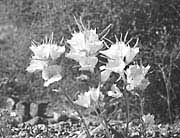
 The most specialized organisms can
be the most vulnerable: What's in a name? In the case of the endangered
Furbish lousewort, a moment of fame in the late 1970s. For without its odd
moniker, this perennial herb with the yellow flowers would surely not have
become well known outside of Maine, where its existence helped stall plans
for dams (eventually canceled for economic reasons) in the late 1970s and
early 1980s.
The most specialized organisms can
be the most vulnerable: What's in a name? In the case of the endangered
Furbish lousewort, a moment of fame in the late 1970s. For without its odd
moniker, this perennial herb with the yellow flowers would surely not have
become well known outside of Maine, where its existence helped stall plans
for dams (eventually canceled for economic reasons) in the late 1970s and
early 1980s.
 Along with the fame came a lesson in evolution and adaptation.
The plant grows on north-facing banks of the St. John River, in well-drained,
calcium-rich, sandy soil. It does best with little competing vegetation,
which the river's big spring runoff helps control. The lousewort is arguably
the most successful organism to exploit those particular conditions. Change
them, and you lose the plant-which means losing biological diversity. As
recent studies of Midwestern prairie habitat have helped confirm, such diversity
is critical for ecosystem survival: The more types of organisms available
to exploit nature's changing niches, the healthier the ecosystem.
Along with the fame came a lesson in evolution and adaptation.
The plant grows on north-facing banks of the St. John River, in well-drained,
calcium-rich, sandy soil. It does best with little competing vegetation,
which the river's big spring runoff helps control. The lousewort is arguably
the most successful organism to exploit those particular conditions. Change
them, and you lose the plant-which means losing biological diversity. As
recent studies of Midwestern prairie habitat have helped confirm, such diversity
is critical for ecosystem survival: The more types of organisms available
to exploit nature's changing niches, the healthier the ecosystem.
10. Caribou
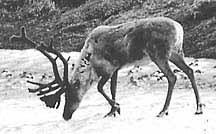
 Calving and oil development don't
mix: Caribou were little more than a distraction in the mid-1970s for oil
companies that had to modify the Trans-Alaska Pipeline so the Central Arctic
herd could cross it. But when developers eyed the Arctic National Wildlife
Refuge, the species became a barricade.
Calving and oil development don't
mix: Caribou were little more than a distraction in the mid-1970s for oil
companies that had to modify the Trans-Alaska Pipeline so the Central Arctic
herd could cross it. But when developers eyed the Arctic National Wildlife
Refuge, the species became a barricade.
 While occasional caribou-mostly bulls-wander near Prudhoe
Bay's oil field and the pipeline, biologists have warned that the Porcupine
herd that migrates to Alaska's northeast edge would be seriously harmed
by gas or oil work and structures. The term "core calving ground"
has acquired political significance, and caribou have been a major factor
in a series of federal decisions to protect the area. The message from the
170,000-strong herd also stands for a fragile web of life that includes
musk-oxen, rich offshore marine life and 135 bird species, including vast
numbers of migrant waterfowl. The oil industry continues to try to pry open
the refuge.
While occasional caribou-mostly bulls-wander near Prudhoe
Bay's oil field and the pipeline, biologists have warned that the Porcupine
herd that migrates to Alaska's northeast edge would be seriously harmed
by gas or oil work and structures. The term "core calving ground"
has acquired political significance, and caribou have been a major factor
in a series of federal decisions to protect the area. The message from the
170,000-strong herd also stands for a fragile web of life that includes
musk-oxen, rich offshore marine life and 135 bird species, including vast
numbers of migrant waterfowl. The oil industry continues to try to pry open
the refuge.
11. Bacteria
 The tiniest wildlife can hold the keys to understanding
human health: In 1978 scientists found that bacteria in Yellowstone National
Park's hot springs contain enzymes that enable replication of the bacteria's
hereditary machinery at high temperatures. For molecular biologists in search
of a way to synthesize DNA fragments, the discovery was big news. Today,
those same enzymes are key to the polymerase chain reaction, which replicates
DNA fragments. Among its many uses, the technique is central to biomedical
research, including studies of the genetics of disease.
The tiniest wildlife can hold the keys to understanding
human health: In 1978 scientists found that bacteria in Yellowstone National
Park's hot springs contain enzymes that enable replication of the bacteria's
hereditary machinery at high temperatures. For molecular biologists in search
of a way to synthesize DNA fragments, the discovery was big news. Today,
those same enzymes are key to the polymerase chain reaction, which replicates
DNA fragments. Among its many uses, the technique is central to biomedical
research, including studies of the genetics of disease.
12. Dusky seaside sparrows
 The Endangered Species Act can't work unless it is enforced:
By 1980, the last five dusky seaside sparrows, all males, were captured
in Florida. The plight of the white-breasted songbird with the patch of
yellow on its dark wings captured the public imagination. In 1987, news
of the death of the last one, named Orange Band, made many obituary columns.
The Endangered Species Act can't work unless it is enforced:
By 1980, the last five dusky seaside sparrows, all males, were captured
in Florida. The plight of the white-breasted songbird with the patch of
yellow on its dark wings captured the public imagination. In 1987, news
of the death of the last one, named Orange Band, made many obituary columns.
 Denizens of salt marshes on and near an island, the
sparrows coexisted with a voracious mosquito population, which humans fought
with pesticides and eradication of marshes. When the Kennedy Space Center
and a development boom ate up more marsh, the bird was in serious trouble-and
the required protection of its habitat under the Endangered Species Act
of 1973 came too little, too late. The last female dusky seaside sparrow
was seen in 1977.
Denizens of salt marshes on and near an island, the
sparrows coexisted with a voracious mosquito population, which humans fought
with pesticides and eradication of marshes. When the Kennedy Space Center
and a development boom ate up more marsh, the bird was in serious trouble-and
the required protection of its habitat under the Endangered Species Act
of 1973 came too little, too late. The last female dusky seaside sparrow
was seen in 1977.
13. HIV
 Humans are still prey: In 1982, scientists gave a name
to a baffling disease that had reached epidemic proportions: acquired-immune-deficiency
syndrome. In 1984, they identified its cause: human immunodeficiency virus.
To a generation that thought of cancer as the last terrible human disease
to be conquered, HIV is a reminder that we are still prey, particularly
for the smallest wildlife. Not only are new diseases a very real threat,
but many known scourges have developed drug-resistant strains.
Humans are still prey: In 1982, scientists gave a name
to a baffling disease that had reached epidemic proportions: acquired-immune-deficiency
syndrome. In 1984, they identified its cause: human immunodeficiency virus.
To a generation that thought of cancer as the last terrible human disease
to be conquered, HIV is a reminder that we are still prey, particularly
for the smallest wildlife. Not only are new diseases a very real threat,
but many known scourges have developed drug-resistant strains.
14. Stoneflies
 Never assume that seemingly useless habitat is unimportant:
In the last decade, scientists have identified whole ecosystems thriving
in places long overlooked. One such region is the world deep within river
beds and floodplains, called the hyporheic zone. There researchers have
found scores of shrimp, worm, bacterium, alga and insect species many never
seen before. Interacting with the river ecosystem, they support a food chain
reaching all the way to humans.
Never assume that seemingly useless habitat is unimportant:
In the last decade, scientists have identified whole ecosystems thriving
in places long overlooked. One such region is the world deep within river
beds and floodplains, called the hyporheic zone. There researchers have
found scores of shrimp, worm, bacterium, alga and insect species many never
seen before. Interacting with the river ecosystem, they support a food chain
reaching all the way to humans.
 One study of the zone under Montana's Flathead River
found immature stoneflies in groundwater 1.5 miles from the river, which
means that pollution or deep digging, even at that distance, could affect
the river's health. How so? Stoneflies are the hyporheic zone's top predators-and
as adults above ground, they congregate at the river and become important
fish food.
One study of the zone under Montana's Flathead River
found immature stoneflies in groundwater 1.5 miles from the river, which
means that pollution or deep digging, even at that distance, could affect
the river's health. How so? Stoneflies are the hyporheic zone's top predators-and
as adults above ground, they congregate at the river and become important
fish food.
 Other newly appreciated ecosystems include the forest
canopy, the ocean floor (where sunless hot-water vents in places like the
Gulf of Mexico feature abundant life) and the deep subsurface of the Earth
(where microorganisms thrive in soil as far down as 9,481 feet).
Other newly appreciated ecosystems include the forest
canopy, the ocean floor (where sunless hot-water vents in places like the
Gulf of Mexico feature abundant life) and the deep subsurface of the Earth
(where microorganisms thrive in soil as far down as 9,481 feet).
15. Northern Pintails
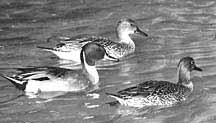
 Even tiny wetlands are critical habitat:
Only a few decades ago, annual wet seasons created millions of ponds across
the Midwest. In these "potholes," great migrations of waterfowl
bred. But in the last 30 years, as farmland development and drainage projects
eliminated many potholes, populations of ducks and other migrant birds declined
dramatically. A decade-long drought starting in 1981 pointed up just how
important the small wetlands can be; waterfowl declined by 40 percent.
Even tiny wetlands are critical habitat:
Only a few decades ago, annual wet seasons created millions of ponds across
the Midwest. In these "potholes," great migrations of waterfowl
bred. But in the last 30 years, as farmland development and drainage projects
eliminated many potholes, populations of ducks and other migrant birds declined
dramatically. A decade-long drought starting in 1981 pointed up just how
important the small wetlands can be; waterfowl declined by 40 percent.
 In the mid- and late 1980s, a number of federal protections
for wetlands went into effect, including required review of all proposed
wetlands activities, the Conservation Reserve Program for farmland, the
North American Waterfowl Management Plan and the EPA's policy of no net
loss of wetlands. Today, thanks to those actions and the efforts of private
groups-along with a wet year-duck populations are at their highest levels
in more than a decade. Still, numbers of northern pintails, one of the 10
major species of ducks, haven't yet recovered.
In the mid- and late 1980s, a number of federal protections
for wetlands went into effect, including required review of all proposed
wetlands activities, the Conservation Reserve Program for farmland, the
North American Waterfowl Management Plan and the EPA's policy of no net
loss of wetlands. Today, thanks to those actions and the efforts of private
groups-along with a wet year-duck populations are at their highest levels
in more than a decade. Still, numbers of northern pintails, one of the 10
major species of ducks, haven't yet recovered.
16. Sea otters
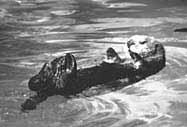
 Oil transportation is terribly flawed:
Though oil had been carelessly carried and spilled the world over long before
the 1989 Exxon Valdez disaster in Alaska's Prince William Sound, images
of the region's oil-slicked and dying sea otters made the point like never
before. The past six years have seen some new regulation, including the
U.S. Oil Pollution Act of 1990. But as continuing spills and their wildlife
victims make clear, oil still is not moved safely. Around the world, aging
tankers and lax regulations comprise disasters waiting to happen.
Oil transportation is terribly flawed:
Though oil had been carelessly carried and spilled the world over long before
the 1989 Exxon Valdez disaster in Alaska's Prince William Sound, images
of the region's oil-slicked and dying sea otters made the point like never
before. The past six years have seen some new regulation, including the
U.S. Oil Pollution Act of 1990. But as continuing spills and their wildlife
victims make clear, oil still is not moved safely. Around the world, aging
tankers and lax regulations comprise disasters waiting to happen.
 The problem exists on land, too. In this country, a
recent audit of the Trans-Alaska Pipeline found 4,920 management, operational
and technical problems. In Russia, a ruptured pipeline last October poured
untold amounts of oil into a fragile Arctic ecosystem.
The problem exists on land, too. In this country, a
recent audit of the Trans-Alaska Pipeline found 4,920 management, operational
and technical problems. In Russia, a ruptured pipeline last October poured
untold amounts of oil into a fragile Arctic ecosystem.
17. Frogs
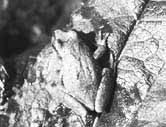
 Amphibians may be an early warning
system for global environmental problems: Realizing that many species of
frogs, toads and salamanders were mysteriously dwindling, scientists from
63 countries compared notes at a meeting in 1989. They found a worldwide
pattern that may have begun as many as 20 years earlier. Among the experts'
guesses for the declines: pesticides, industrial chemicals, habitat loss,
agricultural chemicals or ozone-layer thinning (which is itself caused by
release of synthetic chemicals).
Amphibians may be an early warning
system for global environmental problems: Realizing that many species of
frogs, toads and salamanders were mysteriously dwindling, scientists from
63 countries compared notes at a meeting in 1989. They found a worldwide
pattern that may have begun as many as 20 years earlier. Among the experts'
guesses for the declines: pesticides, industrial chemicals, habitat loss,
agricultural chemicals or ozone-layer thinning (which is itself caused by
release of synthetic chemicals).
 Frogs may be uniquely sensitive to all of the above
insults, since the creatures live in both water and air, and they easily
absorb substances through their skin. Many frogs, which have survived on
Earth for 200 million years, are suffering from weakened immune systems.
Frogs may be uniquely sensitive to all of the above
insults, since the creatures live in both water and air, and they easily
absorb substances through their skin. Many frogs, which have survived on
Earth for 200 million years, are suffering from weakened immune systems.
18. Spotted owls
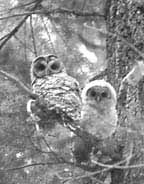
 An animal in trouble is a habitat
in trouble: This ages-old lesson had never caused so much controversy. In
1990, the Northwest's spotted owl was listed as a threatened species, and
the headlines that followed declared a hard choice: jobs or owls.
An animal in trouble is a habitat
in trouble: This ages-old lesson had never caused so much controversy. In
1990, the Northwest's spotted owl was listed as a threatened species, and
the headlines that followed declared a hard choice: jobs or owls.
 The truth was that the trees were becoming scarce, and
timber jobs had already been declining. Still, the publicity pointed up
the critical role a barometer species such as the spotted owl can play in
identifying a whole ecosystem at risk. That last lesson has made such an
impression at the federal level that it has helped generate a new way of
thinking about species conservation dubbed "ecosystem management."
The truth was that the trees were becoming scarce, and
timber jobs had already been declining. Still, the publicity pointed up
the critical role a barometer species such as the spotted owl can play in
identifying a whole ecosystem at risk. That last lesson has made such an
impression at the federal level that it has helped generate a new way of
thinking about species conservation dubbed "ecosystem management."
19. Pacific yew
 The natural world is a rich pharmacy: In 1991, a substance
in Pacific yew bark was found to shrink some cancer tumors. But the tree
was widely reported to be scarce or endangered, and no one knew its population.
Loggers had long considered yews to be trash vegetation in old-growth forests:
Had clear-cutting razed a cure for cancer?
The natural world is a rich pharmacy: In 1991, a substance
in Pacific yew bark was found to shrink some cancer tumors. But the tree
was widely reported to be scarce or endangered, and no one knew its population.
Loggers had long considered yews to be trash vegetation in old-growth forests:
Had clear-cutting razed a cure for cancer?
 As it turns out, yews are plentiful, and researchers
have also created synthetic taxol. As for the drug, it is not a cure, but
it has kept its promise. Taxol shrinks tumors in some patients for months
at a time. Though yew bark got the attention, its lesson can be found in
an array of other wildlife, including leeches (they release a powerful anticoagulant),
the rosy periwinkle (source of an anticancer substance) and frogs (their
skin holds antibiotics).
As it turns out, yews are plentiful, and researchers
have also created synthetic taxol. As for the drug, it is not a cure, but
it has kept its promise. Taxol shrinks tumors in some patients for months
at a time. Though yew bark got the attention, its lesson can be found in
an array of other wildlife, including leeches (they release a powerful anticoagulant),
the rosy periwinkle (source of an anticancer substance) and frogs (their
skin holds antibiotics).
20. Salt cedar
 Weakened ecosystems invite invaders: The introduction
of hearty Eurasian tamarisk (commonly known as salt cedar) and Russian olive
to help halt erosion and serve as ornamentation in parts of the arid West
seemed like a good idea in the 19th and early 20th centuries. But in recent
decades, the trees have almost obliterated native ecosystems along some
rivers in the Southwest-mostly where flood control has dried up floodplains,
weakening native plants such as cottonwoods.
Weakened ecosystems invite invaders: The introduction
of hearty Eurasian tamarisk (commonly known as salt cedar) and Russian olive
to help halt erosion and serve as ornamentation in parts of the arid West
seemed like a good idea in the 19th and early 20th centuries. But in recent
decades, the trees have almost obliterated native ecosystems along some
rivers in the Southwest-mostly where flood control has dried up floodplains,
weakening native plants such as cottonwoods.
 Invaders need not be alien species. One recent study
by U.S. and British ecologists found that fragmentation of a bur oak savanna
in Minnesota led to replacement of the oaks by native weed species. Once
the uniquely adapted oak ecosystem was weakened, it could no longer hold
its ground against the more common invaders, and biological diversity lost
out.
Invaders need not be alien species. One recent study
by U.S. and British ecologists found that fragmentation of a bur oak savanna
in Minnesota led to replacement of the oaks by native weed species. Once
the uniquely adapted oak ecosystem was weakened, it could no longer hold
its ground against the more common invaders, and biological diversity lost
out.
21. Song sparrows
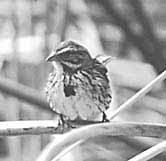
 Overgrazed riparian ecosystems can
recover if given a chance: Three years after the Bureau of Land Management
established a 15-year grazing moratorium on Arizona's San Pedro River in
1988, the number of song sparrows in every 100 acres increased from less
than one to 61. Along the 40-mile section of river, many other Neotropical
migrants also dramatically rebounded, most notably common yellowthroats
and yellowbreasted chats. The exceptionally thorough study was encouraging
news for the cattle-damaged West, where streamside areas support 75 percent
of the wildlife.
Overgrazed riparian ecosystems can
recover if given a chance: Three years after the Bureau of Land Management
established a 15-year grazing moratorium on Arizona's San Pedro River in
1988, the number of song sparrows in every 100 acres increased from less
than one to 61. Along the 40-mile section of river, many other Neotropical
migrants also dramatically rebounded, most notably common yellowthroats
and yellowbreasted chats. The exceptionally thorough study was encouraging
news for the cattle-damaged West, where streamside areas support 75 percent
of the wildlife.
 Without cattle chomping new growth to the ground, young
cottonwood and willow trees, grasses, sedges and reeds all flourished. The
birds found new understory vegetation below existing older trees for feeding,
resting and escaping predators. The birds' recoveries mirrored the rallying
health of many other animals and plants. Even the river has changed: New
growth has stabilized the banks, and the channel is becoming narrower and
deeper, which also has improved the habitat for fish.
Without cattle chomping new growth to the ground, young
cottonwood and willow trees, grasses, sedges and reeds all flourished. The
birds found new understory vegetation below existing older trees for feeding,
resting and escaping predators. The birds' recoveries mirrored the rallying
health of many other animals and plants. Even the river has changed: New
growth has stabilized the banks, and the channel is becoming narrower and
deeper, which also has improved the habitat for fish.
22. Wading birds
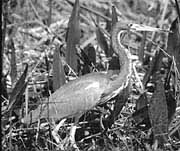
 Altering waterways can have a big
price: Dwindling populations of South Florida's egrets, herons, wood storks
and other wading birds have been eloquently making the point for decades
that canals and drainage systems are drying up the region's famed river
of grass. Last year, Florida instituted a $685 million cleanup plan, and
Congress nearly doubled federal funding for Everglades and Florida Bay restoration
efforts from $28.5 million to $46.6 million. All of that, say field biologists,
will only help start long-term recovery.
Altering waterways can have a big
price: Dwindling populations of South Florida's egrets, herons, wood storks
and other wading birds have been eloquently making the point for decades
that canals and drainage systems are drying up the region's famed river
of grass. Last year, Florida instituted a $685 million cleanup plan, and
Congress nearly doubled federal funding for Everglades and Florida Bay restoration
efforts from $28.5 million to $46.6 million. All of that, say field biologists,
will only help start long-term recovery.
 South Florida's wading birds are not alone in delivering
this message. Last year, the dire plight of Pacific salmon, due largely
to dams on the Northwest's waterways, reached crisis proportions. And in
California's Central Valley, which holds the largest irrigation system in
the Western Hemisphere, wildlife, including fish and migrant waterfowl,
suffered greatly during recent drought years.
South Florida's wading birds are not alone in delivering
this message. Last year, the dire plight of Pacific salmon, due largely
to dams on the Northwest's waterways, reached crisis proportions. And in
California's Central Valley, which holds the largest irrigation system in
the Western Hemisphere, wildlife, including fish and migrant waterfowl,
suffered greatly during recent drought years.
23. Willows
 Plants not only actively defend themselves, some actually
warn other plants: In 1982, plant physiologists were amazed to learn that
tent-caterpillar-infested willows not only change their leaf chemistry to
repel the invaders, but somehow send a warning to other nearby willows to
do the same. Soon after, sugar maples were found also to signal each other.
For about a decade, reports had been piling up of various plants that respond
to insect assaults with bursts of toxic substances in leaves and stems.
But actual plant communication had been unheard of. Then, in 1992, came
the announcement that tomato seedlings send electrical signals to their
leaves that warn of insect chomping. The signals prompt the plant's noninfested
leaves to make chemicals that bugs find difficult to digest.
Plants not only actively defend themselves, some actually
warn other plants: In 1982, plant physiologists were amazed to learn that
tent-caterpillar-infested willows not only change their leaf chemistry to
repel the invaders, but somehow send a warning to other nearby willows to
do the same. Soon after, sugar maples were found also to signal each other.
For about a decade, reports had been piling up of various plants that respond
to insect assaults with bursts of toxic substances in leaves and stems.
But actual plant communication had been unheard of. Then, in 1992, came
the announcement that tomato seedlings send electrical signals to their
leaves that warn of insect chomping. The signals prompt the plant's noninfested
leaves to make chemicals that bugs find difficult to digest.
 All of these phenomena hold great promise for new weapons
in the non-pesticide arsenal against agricultural pests. Today, scientists
are experimenting with vaccines that may provoke plants' defenses.
All of these phenomena hold great promise for new weapons
in the non-pesticide arsenal against agricultural pests. Today, scientists
are experimenting with vaccines that may provoke plants' defenses.
24. Bald eagles
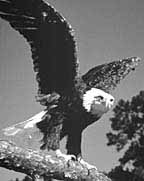
 Without our laws and regulations,
U.S. biodiversity would be far weaker: Last year, the U.S. Fish and Wildlife
Service proposed shifting the bald eagle from the federal category of endangered
(in most of the 48 contiguous states) to the less dire listing of threatened.
The bald eagle promises to join the alligator, the whooping crane, the greenback
cutthroat trout and many other U.S. species that would likely be extinct
by now if not for a safety net of environmental regulation-including the
banning of DDT, protection of habitat and the phaseout of lead shot.
Without our laws and regulations,
U.S. biodiversity would be far weaker: Last year, the U.S. Fish and Wildlife
Service proposed shifting the bald eagle from the federal category of endangered
(in most of the 48 contiguous states) to the less dire listing of threatened.
The bald eagle promises to join the alligator, the whooping crane, the greenback
cutthroat trout and many other U.S. species that would likely be extinct
by now if not for a safety net of environmental regulation-including the
banning of DDT, protection of habitat and the phaseout of lead shot.
 For direct protection of wildlife, the most relevant
legislation is the Endangered Species Act: One recent federal study found
that nearly 40 percent of the species protected by the act are now stable
or recovering. Even so, the act and its implementation are far from perfect.
Hundreds of listed U.S. species likely still face extinction, and many hundreds
more in trouble haven't yet made the list.
For direct protection of wildlife, the most relevant
legislation is the Endangered Species Act: One recent federal study found
that nearly 40 percent of the species protected by the act are now stable
or recovering. Even so, the act and its implementation are far from perfect.
Hundreds of listed U.S. species likely still face extinction, and many hundreds
more in trouble haven't yet made the list.
25. Peregrine falcons
 Toxic chemicals persist in the environment for decades:
After the 1972 ban on DDT in this country, brown pelicans made impressive
comebacks-as did ospreys, peregrine falcons, bald eagles and many other
species. Today, pelican chicks again hatch in the thousands on California's
Anacapa Island. DDT, however, is not gone from our environment. This country
still has enough long-deposited DDT (used to control crop-eating insects
during the 1950s and 1960s) to poison wildlife in some areas. And many other
countries still use DDT and other toxic chemicals that the atmosphere carries
and deposits widely around the globe. Not only that, scientists now understand
that DDT is one of a group of related chemicals that can have similar effects.
Toxic chemicals persist in the environment for decades:
After the 1972 ban on DDT in this country, brown pelicans made impressive
comebacks-as did ospreys, peregrine falcons, bald eagles and many other
species. Today, pelican chicks again hatch in the thousands on California's
Anacapa Island. DDT, however, is not gone from our environment. This country
still has enough long-deposited DDT (used to control crop-eating insects
during the 1950s and 1960s) to poison wildlife in some areas. And many other
countries still use DDT and other toxic chemicals that the atmosphere carries
and deposits widely around the globe. Not only that, scientists now understand
that DDT is one of a group of related chemicals that can have similar effects.
 In the West, certain peregrine falcon populations have
reproductive problems that may be due to DDT or other toxics. One news report
last July told of a researcher using surgical gloves to avoid contact with
a peregrine's toxic-laden eggshells. That detail starkly made the point
that the same chemicals implicated in the birds' reproductive difficulties
also may harm humans. As for brown pelicans-threatened now by various pollutants,
commercial fishing of their food supply and offshore oil development- they
are now telling us the work of saving them is not yet done.
In the West, certain peregrine falcon populations have
reproductive problems that may be due to DDT or other toxics. One news report
last July told of a researcher using surgical gloves to avoid contact with
a peregrine's toxic-laden eggshells. That detail starkly made the point
that the same chemicals implicated in the birds' reproductive difficulties
also may harm humans. As for brown pelicans-threatened now by various pollutants,
commercial fishing of their food supply and offshore oil development- they
are now telling us the work of saving them is not yet done.

Lisa Drew is a National Wildlife senior editor. Research assistant
Laura Gemery Hutman and NWF librarian Sharon Levy helped report and research
this article.


















